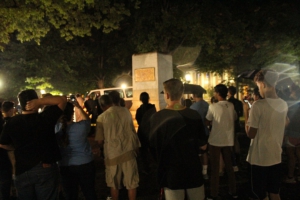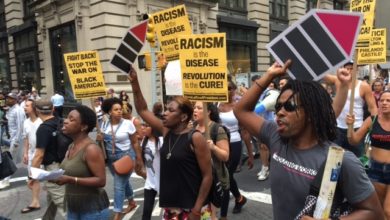
Support anti-racist protesters at the trial on November 5 or contributing to Durham Solidarity Freedom Fighter Bail Fund.
Silent Sam, the University of North Carolina’s idol to the Confederacy has been the focal point of much struggle on campus where anti-racist activists have had repeated bitter encounters with both police and white supremacists.
Given no legal means of removing the statue and having spent a year attempting to even just meet with campus administrators to no avail, the campus and local community took it into their own hands to remove this blight from UNC’s lawn.
On Aug. 20, several banners on large polls were erected and carried to the statue. Campus police attempted to encircle and protect the statue but with their numbers dwarfed by protestors and unable to effectively control the situation, they had the choice to either stand down or intensely escalate the situation. They chose the former. The banners were used to enclose and conceal the statue, while behind the banners, activists affixed a rope to the statue. People collectively seized the rope and tore Silent Sam from its pedestal to cheers.
However, the demonstration had its less sublime side as well. White supremacists threatened some demonstrators and violently assaulted and beat others. One violent white nationalist, Joshua Pennington, pulled a knife out and threatened anti-racist activist Tim Osborn and threatened to gut him while police looked on. Indeed police did not respond to any of these incidents even when notified. The next day, the administration began lashing out against protestors trying to put forth an “outside agitator”narrative and a number of arrest warrants went out.
The toppling of Silent Sam drew the ire of white supremacist groups like ACTBAC and League of the South who have organized several demonstrations around what anti-racist protestors have come refer to as Silent Stump (the empty pedestal on which Silent Sam once stood). At these events, police have provided parking and armed escort for the neo-Confederates, which is unsurprising given that Nazi SS tattoos have been spotted on officers themselves.
On September 4, a group of white supremacists organized a vigil for Confederate soldiers to which anti-racist student organizers responded by organizing a simultaneous dance party to get a large section of the campus community involved.
A coalition of police departments from across the state were assembled and responded by mass pepper-spraying the crowd.
At a subsequent protest on September 8, another white supremacist demonstration was called; counter-demonstrators organized an anti-racist potluck and canned food drive. This food was seized by police as a potential “weapon” and never donated to the local shelter.
After the white supremacists had finished their action and were graciously escorted back to their cars by police, the police, without provocation, turned violently against the crowd of counter-demonstrators. Riot police burst from Graham Building, tackled random people to the ground and smashed heads forcefully against brick.
While under arrest during this incident, this journalist was taken inside Graham Building where I was able to count a total of 62 officers. At the sheriff’s department, arresting officers later made threatening jokes about beating us while we remained cuffed.
In general, police and administration have maintained a safe environment for white supremacists and neo-Nazis while pursuing harsh repression against anti-racist activists. Police have especially focused on charging and getting trespass notices against the movement’s internal security and street medics.
The State Bureau of Investigation joined the investigation against anti-racist activists and sent agents into the UNC Physics department to bully staff members into releasing protected information about students, falsely claiming that staff was legally required to do so.
The struggle around Silent Sam, now Silent Stump, on UNC campus has been the site of white supremacist terror and violence as well as violent state repression and surveillance by the police. Just last month, Maya Little faced two trials, one criminal, one academic, for their non-violent protest of Silent Sam in May. In both cases, the grad student and activist was technically found guilty but spared any serious legal or academic consequences due no doubt to campus and community solidarity. Now more anti-racist, anti-Sam protesters face legal charges and will be going to trial Nov. 5. Organizers are calling for people to support them either in person or by contributing to Durham Solidarity Freedom Fighter Bail Fund.






